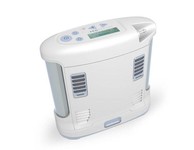Top 3 Best Portable Oxygen Concentrators 2020 (Ranked & Reviewed by Experts)
We Reviewed, Tested the Best Continuous Flow Oxygen Concentrator in the US 
Portable oxygen concentrators or POCs represent medical grade breathing devices aimed at patients with sleep apnea or other breathing-related conditions. Once, oxygen concentrators used to be heavy, difficult to use and they would allow minimum freedom of movement. Today, portable oxygen concentrators are small, compact and highly efficient devices equipped with heavy-duty batteries meant to provide patients with the most efficient treatment available whether at home or traveling.
There is a wide selection of POCs available on the market, but when choosing the perfect device, patients should make a well informed and educated decision. They should be able to select the perfect concentrator, suitable for their personal needs.
Considerations when choosing portable oxygen concentrators
- Dimensions and weight
The working definition of “portable” can vary widely between oxygen-concentrator users, but most would agree that full-size oxygen tanks mounted on a cart are not easily portable. There are some models that are extremely compact and lightweight, to the point where they can be attached to the user’s belt or waist. Others can be placed in a small carrying bag or backpack with ease. Portable oxygen concentrators can weigh anywhere from a few pounds to over 30 pounds in the case of high-output medical-grade machines.
- Oxygen delivery
There are essentially two ways a portable oxygen concentrator delivers the nearly pure oxygen it extracts from the air. One method is called a pulse dose. The machine’s sensors measure the user’s breathing rate and automatically deliver a short burst of oxygen as needed. This is a more popular choice for those with higher-functioning lungs or those seeking an oxygen boost at higher altitudes.
The other delivery method is a continuous flow. The oxygen concentrator maintains a steady supply of oxygen to the user while it is being produced. This generally requires a heavier model with more power, and some oxygen is wasted along the way. Users with limited lung capacity or higher oxygen saturation requirements usually prefer a continuous-flow concentrator.
- Ease of maintenance
There are some complicated moving parts on a portable oxygen concentrator, along with hoses, nasal cannulas and masks that need to be kept in sanitary condition. Most portable oxygen concentrators also require filters, and some maintain a reservoir of sterile water for purification. When comparing concentrator models, you should consider how challenging it would be for the user to make repairs, clean the attachments and store the machine between uses.
- Noise level
Most oxygen concentrators do generate noise during operation because of the moving parts and the delivery system. Some create a tolerable “white noise,” akin to radio static, in the background, Others are much noisier, especially the models designed for continuous flow. Asking for an in-store demonstration or consulting consumer reviews should help buyers determine if a particular model is quiet enough.
Below are the best portable oxygen concentrators of 2020, as ranked by our product experts.
OCTOBER 2020 TOP CHOICE
SAVE
50%

- 1
- Tested #1 in 2020
- Best POC on the Market
- 24 Hour Continuous Flow
- Quiet (sleep mode)
- Improves blood circulation, increases heighten concentration, boost the immune system
- Great for travel & in your car, looks more like an outdoorsy lunch bag than a medical device
- Great for couple - at the same time
- Fully controllable by remote, easy for the elderly to operate it freely at night
- Large screen data in real-time, convenient for the elderly view the screen data
- Ships from USA, fast delivery
- Money back warranty
- 20% OFF LIMITED DEAL!
9,8
Excellent

Inogen One G3: Best POC over $2000
- 2

The G3 is one of the quietest portable oxygen concentrators available, but this efficient device has a lot more going for it. It boasts a four-hour battery life and an operational altitude of 10,000 feet, and the carrying case looks more like an outdoorsy lunch bag than a medical device.
The G3 also always puts your health first with audible alerts in case of a power outage, no breath detected alarms, and oxygen purity checks. Rest assured, if your oxygen level ever falls below required purity levels, you will know immediately.
- Expensive ($2295)
- Slow delivery
9,5
Great
- 3
- Touch Screen Control and HD LCD Screen
- 180m long time use
- Adjustable Oxygen Concentration
- Boost the immune system
- Natural remedy for headaches
- Quite: less than 45 decibels
- Power saving. Auto power off.
- Limited Stock
9,3
Great
Why The DEDAKJ™ POC Is Our Top Choice In 2020
DEDAKJ™ is an incredibly powerful, compact and efficient Pulse Dose machine, equipped with an advanced technology motor and several helpful features. The device is a top reliable choice for patients who need to use the POC on a 24-hour basis. When you purchase the Inogen One DEDAKJ oxygen concentrator, you will receive AC and DC cords, and integrated batteries.
DEDAKJ™ is equipped with an advanced trigger sensitivity mechanism in order to provide patients with the best reliability during therapy. The device is capable of detecting the breath phase and it will deliver oxygen upon this phase to create the most natural breathing pattern.
Features
- Power supply
While standard-size portable oxygen concentrators typically use a dedicated AC power supply, portable models often operate on both AC and rechargeable batteries. There may be a removable AC wall plug for in-home use, and a battery pack for traveling. Because larger continuous-flow models can draw a significant amount of power, there should be a sensor that indicates when a recharge is needed. A DC car adapter is also a good option for travelers.
- Accessories
One noticeable difference between entry-level, mid-range and higher-end oxygen concentrators is the number of accessories included. Some units include a remote control for a more hands-free experience. An automatic shut-off timer is also a good feature. Additional masks and nasal cannulas make maintenance much easier. An air humidifier attachment also addresses other breathing issues, including allergies and asthma.
- Price
Portable oxygen concentrators feature advanced technology, so their retail price points can be considerable. A basic pulse dose model with minimal accessories starts at $350, while mid-range brands with either pulse dose or continuous flow cost between $350 and $500. Higher-end continuous-flow machines packed with features can cost as much as $1,500 or more.
POC: Frequently Asked Questions
What is the difference between Continuous Flow and PulseDose?
Both Continuous Flow and Pulse Dose represents the way in which the oxygen is delivered to the patient by the concentrator. Pulse Dose means that the oxygen is delivered to the patient only when the patient initiates a breath. A continuous flow means that the machine delivers oxygen on a constant level. It is important to mention that most available POCs with a Continuous Flow will also have the Pulse Dose option available.
Is it safe to use Pulse Dose setting during the night?
The majority of physicians will recommend the use of Continuous Flow while sleeping. However, you should ask your doctor for more details regarding whether or not you can use Pulse Dose setting during sleep.
Can you use your POC when traveling internationally?
Most portable oxygen concentrators will have an international power supply. You just need to use the compatible adapter for 100v, 250v / 50 or 60hertz respectively.
How about using your POC while traveling by car?
You can use your POC while traveling by car. You just need to use the DC adapter supplied with your machine. Replacement DC adapters are also available.
How much does a portable oxygen concentrator cost?
Prices may vary depending on several factors such as brand, POC type, extra functions, batteries and other aspects. POCs can start at around $1400 and go up to $3,500 or more.




